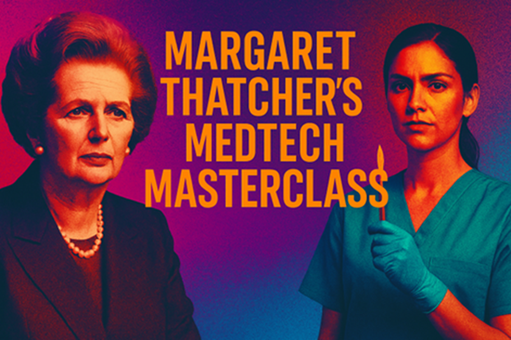Namal Nawana’s leadership at Smith & Nephew illustrates what this looks like in practice. When he took the helm in 2019, the company had a strong legacy but limited global velocity. Nawana pushed aggressively into emerging markets, prioritised strategic acquisitions that aligned with growth geographies, and restructured operations to reflect a global - not Western - future. Under his leadership, Smith & Nephew began to look less like a traditional British MedTech and more like a borderless platform for surgical innovation.
Thatcher understood that influence was not granted - it was constructed. MedTech leaders should adopt a similar posture. This means engaging not just in markets, but in movements: shaping global regulatory convergence, advocating for access in underserved health systems, forming public-private partnerships that move the needle on affordability and delivery. It means going beyond the balance sheet to build reputational capital that opens doors in India, Brazil, the Middle East, Southeast Asia, and Africa - not just Wall Street or Brussels.
Female CEOs, particularly those thrust into turnaround roles, may be underestimated by legacy investors or competitors. But that is itself an opportunity. Thatcher never waited for permission to lead beyond her domestic base - she imposed her vision globally. Likewise, today’s MedTech leaders must play bigger than their current footprint. They have the chance to define the next frontier of the industry - not as responders, but as architects. To lead globally is not a vanity project. It is a strategic imperative. As Thatcher showed, conviction can become currency. And in today’s MedTech, those who combine growth with equity will not only transform markets - but they will also reshape what leadership in healthcare looks like.
Legacy and Longevity: Institutionalising Change
Margaret Thatcher did not just fix Britain’s problems - she rewired its operating system. Her reforms changed how the UK economy functioned, how labour interacted with government, and how Britain positioned itself on the global stage. Even her fiercest critics must contend with this: decades after she first took office, the structures she reshaped - privatised industries, deregulated markets, and a leaner, more global-facing state - still frame key debates today. That is the essence of real leadership: not personal dominance, but institutional endurance.
In MedTech, the bar should be just as high. The most consequential leaders - especially those stepping into fragile or failing organisations - must look beyond short-term wins and quarterly optics. Transformation is not cosmetic. It is structural. It lives in rewired innovation cycles, redefined performance cultures, and redesigned talent pipelines. It is felt long after the leader has left the stage.
This is critical for women leading in turnaround environments. Too often, the narrative focuses on resilience, personal grit, or “heroic” efforts under pressure. But leadership that lasts is not about heroics - it is about systems. It is about codifying a culture that prizes agility over hierarchy, rewards insight over incumbency, and builds institutional memory that does not vanish with the next succession.
Consider how some of today’s most forward-looking MedTech firms are evolving: embedding AI not just as a tool but as a mindset, decentralising R&D to tap global insight, building leadership pipelines that reflect the diversity of their patient populations. These are not symbolic changes. They are foundational.
Thatcher’s legacy did not begin with her voice, or even her cabinet - it began with the clarity of her intent. But it endured because she built structures that shifted national direction. Her influence outlasted her office, crossed oceans through her alignment with Reagan, and still echoes in policy and political strategy around the world. That kind of legacy is not about longevity - it is about impact.
For MedTech leaders, especially women rewriting the rules in male-dominated institutions, the question is not just whether they can fix what is broken. It is whether they can build something that holds, scales, and endures. Thatcher did not aim to be remembered. She aimed to be irreversible. That is the kind of leadership the future of MedTech demands.
Takeaways
Margaret Thatcher did not wait to be accepted. She did not ask for a seat at the table - she bulldozed the table, rewrote the rules, and built a new game. Not because she led as a woman, but because she led with vision, force, and unapologetic intent. And that is what the next generation of MedTech’s transformational leaders - many of them women - must do. The terrain is different now, but the resistance is familiar: bureaucratic drag, underpowered teams, legacy systems, and subtle doubt in every room. The instinct might be to fix quietly, to lead cautiously, to soften the edges. Don’t!
This moment does not call for caretakers. It calls for catalysts.
The future of MedTech belongs to those who can stabilise the system and simultaneously reinvent it. Who can navigate warning letters, sinking valuations, and global complexity - and still bet boldly on what is next. This is not about proving yourself. It is about building something that outlasts you. Thatcher’s real legacy was not her resilience. It was her irreversibility. The mandate for today’s MedTech leaders? Be clear. Be disciplined. Be bold. And when you lead -make it permanent.
|

